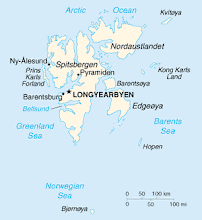The size of Ireland, Svalbard is located 1,000km (623 miles) north of the Norwegian mainland, nearly equidistant between Norway and the North Pole, and extends from 74ºN to over 80º N. The island group is off the NE coast of Greenland, and north of Iceland. It's made up of three main islands, but only Spitsbergen on the west supports human colonies. There are 5 population centers, Longyearbyen is the largest, with a year round population of 1,500 and is the location of one of two airports.
Average daily temps reach 25-45ºF but nighttime temps can dip terribly low, such as to -20ºF at times.
The whole of Svalbard is gripped in sea ice for most of the year and much of the interior is covered in glaciers and ice fields. Although the west coast remains ice free for most of the summer, pack ice hovers just north of the main island year round and vast sheets and rivers of ice cover approximately 60% of the land area.
Lonyearbyen was the main export site for the rich coal seams that characterize the island. There are all sorts of abandoned coal mining detritus in the area, but the little city also enjoys a superb backdrop that includes two tongues of the Lonyearbyen glacier just outside of town.
SEA ICE
Glaciers drop enormous chunks of ice all around the Arctic Ocean. Sea ice breaks up and sends tabulars out and about to drift on currents. The Beaufort Gyre off the Beaufort sea of Alaska is home for a collection of ice bergs that circle clockwise for up to 3-5 years. Many of these are spun off into the Fram Straight, which flows down between the northeast corner of Greenland and the Svalbard Islands. Most of the ice found in the Fram Straight has come originally from the entire north coast of Russian Siberia and joins together to form the Transpolar Drift. It's rather like several very large freight trains all converging onto one track.
Considerable research in recent years has revealed the formation process and structure of sea ice to be quite complex.
SIGNIFICANT ARCTIC RESEARCH PROJECTS
Since the early 1970's satellite microwave sensors have provided routine sea ice and polar ocean observations. Such large-scale observations of sea ice coverage have become increasingly important to research on global environmental change.
There are dozens of Arctic Sea Ice research studies continuing from the 1990s. Among them are the International Tundra Experiment, Surface Heat Budget of the Arctic ocean, International Northern Sea Route Programme, Mackenzie Basin Impact Study, Ice Cores of the Greenland Ice Sheet, Nuclear Submarines and Arctic Oceanography, International Expeditions to the Russian Arctic Coast, US/Canada Arctic Ocean Section Expedition, among others with many nations involved in chronicling, recording and assessing the earth's changing climate.
Friday, July 25, 2008
Subscribe to:
Post Comments (Atom)














2 comments:
Wow, Lou, Back to your families roots. Awesome. I see your dads smile.!!
LOL
Jim
Hi Louise, This is Arthur from Belgium on the Shokalskiy from July 26 - August 5 at Svalbard. We met the last evening when you came in. It was great to see you again. We had a great adventure at Svalbard. I am sure you will have a great time too. If this message reaches you during the voyage, please greet the staff for me. I'll keep following your blog here. Have a great one.
Post a Comment